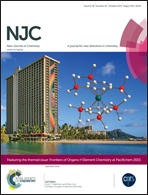Hydrogen-gas sensors based on graphene functionalized palladium nanoparticles: impedance response as a valuable sensor†
Abstract
Palladium–graphene (PdGO) nanostructures with high-quality-graphene layers and well monodispersed palladium nanoparticles (PdNPs) were synthesized by the hydrothermal microwave exfoliation method. The structural and morphological characteristics of PdGO were investigated, and the results indicate that the hydrothermal-microwave method allows both the reduction of metal precursors and their anchorage on highly exfoliated graphene layers. The synthesized PdGO nanostructures were then deposited as active layers for sensing hydrogen gas (H2). PdGO-based sensors with gas concentrations from 0.01 to 5 vol% in air exhibited a very reproducible performance with fast response times (∼30 s) and recovery behavior at room temperature. Measurement of impedance response serves as a highly sensitive feasible sensor technique. Our results show that it is feasible to obtain an efficient H2-sensor with reliable and reproducible sensing properties by means of a simple and cost-effective preparation method under real atmospheric conditions.


 Please wait while we load your content...
Please wait while we load your content...